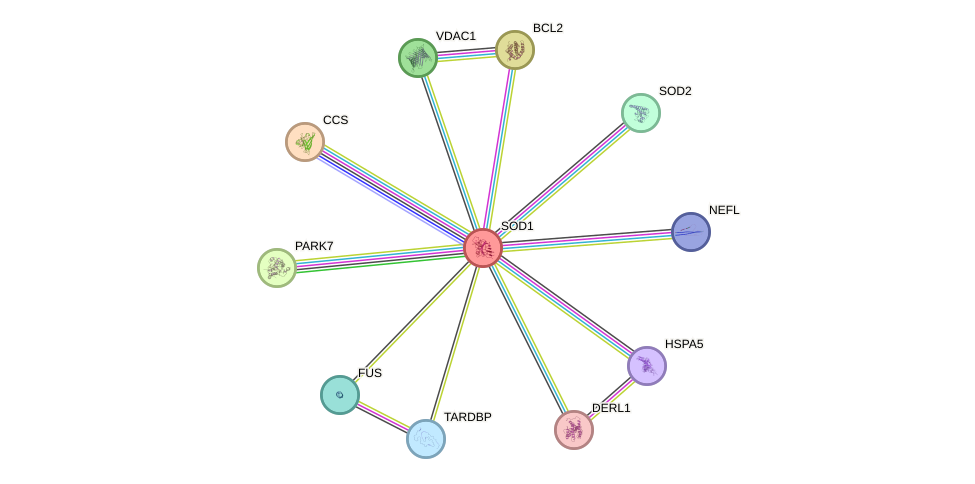GenAge entry for SOD1 (Homo sapiens)
Gene name (HAGRID: 130)
- HGNC symbol
- SOD1
- Aliases
- IPOA; ALS; ALS1
- Common name
- superoxide dismutase 1, soluble
Potential relevance to the human ageing process
- Main reason for selection
- Entry selected based on evidence directly linking the gene product to ageing in a non-mammalian animal model
- Description
SOD1 is an antioxidant. It is the predominant member of the SOD family found in the cytoplasm. Initial results from invertebrates suggested a role for SOD1 in ageing. Overexpression of SOD1 and CAT in short-lived strains of fruit flies extends lifespan and appears to delay ageing [39], but the same effects are not witnessed in long-lived strains [40].
Early SOD1-null mice models were found to develop normally and did not show signs of premature ageing, though they were vulnerable to motor neuron loss after axonal injury [45]. In a more recent study the kidneys of SOD1-null mice exhibited increased DNA damage, increased senescent cells, and increased inflammation. Subjecting these mice to dietary restriction attenuated these effects [4485]. RGN/SOD1-double knockout mice exhibit abnormal plasma lipid metabolism, hepatic lipid accumulation and premature death resulting from impaired VLDL secretion, both compared to wild type, SMP30-knockout and SOD1-knockout mice [3618]. Overexpression of human SOD1 in transgenic mice results in neurodegenerative changes [663]. In humans, mutations in SOD1 have been associated with amyotrophic lateral sclerosis [671]. A role for SOD1 in human ageing, while not impossible, remains to be determined.
Cytogenetic information
- Cytogenetic band
- 21q22.11
- Location
- 31,659,622 bp to 31,668,930 bp
- Orientation
- Plus strand
Protein information
- Gene Ontology
-
Process: GO:0000187; activation of MAPK activity
GO:0000302; response to reactive oxygen species
GO:0000303; response to superoxide
GO:0001541; ovarian follicle development
GO:0001819; positive regulation of cytokine production
GO:0001890; placenta development
GO:0001895; retina homeostasis
GO:0001975; response to amphetamine
GO:0002262; myeloid cell homeostasis
GO:0002576; platelet degranulation
GO:0006749; glutathione metabolic process
And 50 more GO terms Cellular component: GO:0005576; extracellular region
GO:0005615; extracellular space
GO:0005634; nucleus
GO:0005654; nucleoplasm
GO:0005737; cytoplasm
GO:0005739; mitochondrion
GO:0005758; mitochondrial intermembrane space
GO:0005759; mitochondrial matrix
GO:0005764; lysosome
GO:0005777; peroxisome
GO:0005829; cytosol
And 11 more GO terms
Show all GO termsFunction: GO:0004784; superoxide dismutase activity
GO:0005507; copper ion binding
GO:0005515; protein binding
GO:0008270; zinc ion binding
GO:0030346; protein phosphatase 2B binding
GO:0042802; identical protein binding
GO:0042803; protein homodimerization activity
GO:0048365; Rac GTPase binding
GO:0051087; chaperone binding
Protein interactions and network
- Protein-protein interacting partners in GenAge
- TXN, PIN1, BCL2, CAT, SOD2, SOD1, PRDX1, RGN, HSPA9, PCMT1, HSPA8, RAE1, STUB1, GPX4, TRAP1
- STRING interaction network
Retrieve sequences for SOD1
Homologs in model organisms
- Caenorhabditis elegans
- sod-5
- Danio rerio
- sod1
- Drosophila melanogaster
- Sod
- Mus musculus
- Sod1
- Rattus norvegicus
- Sod1
- Saccharomyces cerevisiae
- SOD1
- Schizosaccharomyces pombe
- sod1
In other databases
- GenAge model organism genes
- GenDR gene manipulations
- A homolog of this gene for Saccharomyces cerevisiae is present as SOD1
- LongevityMap
- This gene is present as SOD1
- CellAge
- This gene is present as SOD1

